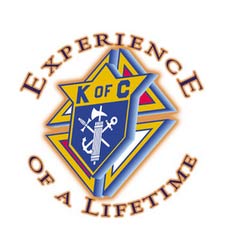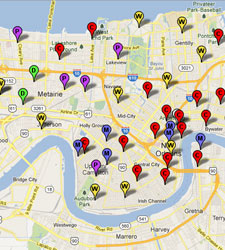Rectory 504-899-1378 | Fax 504-899-0480
School 504-891-1927
ststephenpar@archdiocese-no.org
From the Pastor – April 27, 2025
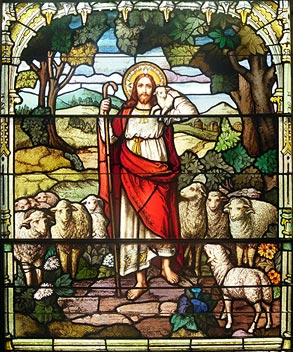 Jesus came, although the doors were locked, and stood in their midst and said, “Peace be with you.”
Jesus came, although the doors were locked, and stood in their midst and said, “Peace be with you.”
Then he said to Thomas, “Put your finger here and see my hands, and bring your hand and put it into my side, and do not be unbelieving, but believe.” Thomas answered and said to him, “My Lord and my God!” Jesus said to him, “Have you come to believe because you have seen me? Blessed are those who have not seen and have believed.” (Jn 21-26-29)
We call him “Doubting Thomas,” but the words spoken by Thomas after he touched the hands and side of Jesus are the most important of John’s Gospel because they form a literary “inclusion” with the very first words of the Gospel. In John 1:1 we read: “In the beginning was the Word, and the Word was with God, and the Word was God.” And then that Word was made flesh in the person of Jesus Christ. And Thomas identifies Jesus as the “Word Made Flesh” after the Resurrection. And he finalizes John’s Gospel with his own punctuation mark: “My Lord and my God!”
While Jesus “gently” chides Thomas for his unbelief, He also gives a special benediction to us: “Blessed are those who have not seen and have believed.” We are those who are blessed because we believe in Jesus Christ without having touched His pierced hands or side.
Over the course of this past year, 10 old and young people (their names listed in the right column) have been added to that list of blessed. They have experienced God’s grace working in their lives, and they have responded to that grace by gathering weekly to learn more and more of what the Church teaches about Jesus Christ. And although they have not seen His resurrected body, they believe. They believe in His divinity. They believe in His life, death and resurrection. They believe in His Church. And they believe in His Sacraments. And now believing, they actually do touch Him when they receive Him in Holy Communion. Blessed are they!
But the last words of the Gospel passage today aren’t the absolute last words of John’s Gospel. The last words are: “There are also many other things that Jesus did, but if these were to be described individually, I do not think the whole world would contain the books that would be written.” This might fill us with wonder of the other miracles of Jesus that aren’t contained in the Gospel. But there’s a simpler answer. The reason that the world can’t contain the books is that the books are still being written. They’re being written about the things Jesus has done in the lives of 10 people over this past Easter week. And they’ve yet to be written about those who might experience the “things that Jesus might do” next year. And the year after that. And the year after that. Blessed are we who believe. Blessed are we about whom those books are being written.
(Very Rev. Msgr.) Christopher H. Nalty
msgr.nalty@gmail.com
Masses
St. Stephen
Saturday Vigil at 4:00 pm
Sunday at 8:00 am and 10:30 am
Sunday at 5:00 pm at OLGC
Our Lady of Good Counsel (OLGC)
Center of Jesus the Lord
Charismatic Mass
Sunday at 10 am
Weekdays Masses
Monday – Friday 6:30 am St. Henry
Tuesdays 6:00 pm St. Stephen
First Fridays 6:00 pm Latin Mass
Adoration of the Blessed Sacrament
Tuesdays 4:45 – 5:45pm St. Stephen
Thursdays 7:00 – 8:00am St. Henry
Confession Times at Good Shepherd
Saturdays 3:00 – 3:45pm St. Stephen
Sundays 9:30 – 10:15am St. Stephen
Sundays 10:00 – 10:30am OLGC
First Fridays 6:30 – 7:00pm OLGC
Newsletter Sign Up
Novena in Memory of Pope Francis
The entire Church mourns the death of the Holy Father, Pope Francis. In cathedrals, basilicas, parish churches, shrines, and chapels the Holy Eucharist will be offered for the repose of his soul. Communities and individuals will ask God to bestow his infinite mercy on the man who served the Church as Bishop of Rome.
This novena has been prepared to help pray for the Pope during the time of mourning. The daily novena – lasting for the novendiales period from April 26 to May 4, 2025 – consists of a short reading from Scripture or some other ecclesiastical text and some brief prayers, including orations drawn from the Roman Missal and the Order of Christian Funerals.
Pray for our Holy Father, Pope Francis
(December 17, 1936 – April 21, 2025)
O God, who in your wondrous providence chose your servant Pope Francis to preside over your Church, grant, we pray, that, having served as the Vicar of your Son on earth, he may be welcomed by Him into eternal glory. Who lives and reigns with you in the unity of the Holy Spirit, God, for ever and ever. Amen.
V. Eternal rest grant unto Francis, O Lord.
R. And let the perpetual light shine upon him.
And may his soul, and the souls of all the faithful departed,
through the mercy of God, rest in peace.
Amen.
Alleluia!
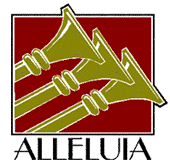
Easter Sunday is the day of the “Alleluia!” After forty days of Lenten sacrifice and fasting, we finally arrive at the most important day of our liturgical year, and the only word we have to express our inner joy is “Alleluia!!”
In the old Greek version of the Book of Tobias, in the Septuagint Greek translation of the Hebrew psalter, and in the original Greek of the Apocalypse we hear about this most holy word. It is part of the earliest Christian liturgies of which we have record.
It is a word composed of the divinely acclaiming verbal form Allelu and the divine pronoun term Ya (for YHWH or Yahweh). So, preserving its radical sense and sound, and even the mystical suggestiveness of its construction, it may be literally rendered, “All hail to Him Who is!”–taking “All Hail” as equivalent to “Glory in the Highest,” and taking “He Who is” in the sense in which God said to Moses: “Thus shalt thou say to the children of Israel; WHO IS hath sent me to you.” The ancient Jewish and Christian tradition all point to the conclusion that the “Alleluia” belonged to the Hebrew liturgy from the beginning as a divinely authorized doxology. As to when it was first formed, much evidence points to it being one of man’s most ancient formulas of monotheistic faith–the true believer’s primitive Credo, primitive doxology, primitive acclamation. That in part would explain remarkable fondness for its liturgical use. As a rule the Church uses it wherever joy is to be emphatically expressed, especially as to triumph or thanksgiving.
The “Alleluia” is a great characteristic of Easter, as it has an important place in all of the liturgies, constantly appearing at the beginning and end, and even in the middle, of psalms, as an instinctive exclamation of ecstatic joy.
The very sound of the words should be held to signify a kind of acclamation and a form of ovation which mere grammarians cannot satisfactorily explain; this is the reason why the translators of the Old Testament have left it untranslated, and the Church has taken it into the formulas of her Liturgy or of the people who use it at any time or place where joy need be expressed for God’s greatness and love! Alleluia! Praise God!
Altar of Repose
Mass of the Lord’s Supper
At the Mass of the Lord’s Supper on Holy Thursday (7:00 PM) sufficient hosts are consecrated for that Mass and for the next day. These consecrated Hosts remain in a ciborium on the corporal in the center of the altar until the end of Mass, after which they are carried in Solemn Procession to the Altar of Repose, with the priest vested in a Cope and Humeral Veil, and covered with a canopy. The Blessed Sacrament remains in the temporary tabernacle at the Altar of Repose, and the Holy Thursday service concludes with the stripping of all altars except the Altar of Repose.
Holy Thursday is a day of exceptional devotion to the Blessed Sacrament, and the repository is the center of the love, prayers and aspirations of the faithful. After the Good Friday service, the Blessed Sacrament remains available only as viaticum for the dying and for Communion given on Good Friday at the service called The Veneration of the Cross (Good Friday at 3:00 PM). While the Blessed Sacrament remains in this temporary tabernacle at the altar of repose, a lamp or candle is always kept burning.
On Holy Thursday we will celebrate the Mass of the Lord’s Supper at 7:00 PM, which commemorates the institution of the Holy Eucharist when Jesus washed his Apostle’s feet. This Mass begins the Sacred Triduum. This year Adoration at this Altar of Repose will take place all night, from the end of the Holy Thursday Mass until the sun rises on Good Friday at 6:00 AM.
PLEASE SIGN-UP to take an hour or a half-hour of the Vigil! Sign-up sheets are in the back of church.
Stations of the Cross
There will be Stations of the Cross and Confessions on Fridays of Lent at the Basilica of St. Stephen with Confession at 5:30pm and the Stations at 6:00pm. Remember that Msgr. Nalty is also in the Confessional from 3:00-3:45 pm on Saturdays and 9:00-10:15 am on Sundays.
Easter Baskets for the Needy
THANK YOU! Because of your financial contributions the St. Vincent du Paul Society was able to distribute Easter Food Baskets to 30 families during Holy Week, each including a $50.00 gift certificate from Rouse’s for the main course. We are so grateful for your continued support of our mission to serve those in need!
Nine Church Walk
Thanks to our volunteers who greeted pilgrims taking part in the Nine Church Walk on Good Friday. The pilgrims started arriving almost at the completion of our Holy Thursday vigil at 6:00am, and they continued into the early afternoon, until we started preparing for the Good Friday service. In past years we’ve had well over 2,000 people came to visit St. Stephen’s on Friday, and the last two years the groups have been very small due to COVID19. We were glad to see the large groups this Good Friday! Anybody who doubts the vitality of the Catholic Church in New Orleans need only to see the busloads of high school groups, CYO groups, and large families taking part in the walk to have their doubts removed. It was a joy to greet many pilgrims from other parishes in the Archdiocese.
Divine Mercy
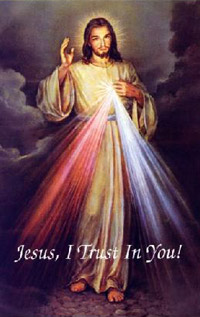
Divine Mercy Sunday is dedicated to the devotion to the Divine Mercy promoted by St. Faustina , and is based upon an entry in St. Faustina’s diary stating that anyone who participates in the Mass and receives the sacraments of confession and Eucharist on this day is assured by Jesus of full remission of sins.
According to the notebooks of Saint Faustina, Jesus made the following statements about this day: “On that day the very depths of My tender mercy are open. I pour out a whole ocean of graces upon those souls who approach the fount of My mercy. The soul that will go to Confession and receive Holy Communion shall obtain complete forgiveness of sins and punishment. On that day all the divine floodgates through which grace flow are opened. Let no soul fear to draw near to Me, even though its sins be as scarlet. My mercy is so great that no mind, be it of man or of angel, will be able to fathom it throughout all eternity.” (Diary of Saint Faustina, 699)
The devotion was celebrated unofficially in many places for some years. However, on April 30, 2000 (Divine Mercy Sunday of that year), Pope John Paul II canonized St. Faustina and designated the Sunday after Easter as Divine Mercy Sunday in the General Roman Calendar , with effect from the following year. He also decreed a plenary indulgence associated with this devotion. Pope John Paul II said he felt a closeness to St. Faustina when he was writing his letter Dives in misericordia. He died during the vigil of the Divine Mercy Sunday in 2005.
Divine Mercy Sunday may be the greatest day of the year because of the immeasurable amount of grace Jesus promised to pour forth on this day. In the private revelation accepted publicly by the Church, Jesus made a specific promise to Saint Faustina about Divine Mercy Sunday:
“On that day… The soul that will go to Confession and receive Holy Communion shall obtain complete forgiveness of sins and punishment.” (Diary, 699)
The Story of the Palms
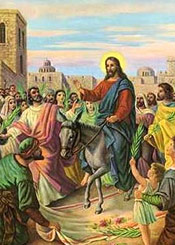 It was a common custom in many lands of the ancient Middle East to cover in some way the path of someone thought worthy of the highest honor. In 2 Kings 9:13 Jehu, son of Jehoshaphat, was treated to this honor. Each of the four Gospels report that the people of Jerusalem gave Jesus the honor of walking on a covered path. However, in the synoptic Gospels (Matthew, Mark and Luke) we hear that the people lay their garments and cut rushes to place on the street. Only the Gospel of John specifically mentions palms.
It was a common custom in many lands of the ancient Middle East to cover in some way the path of someone thought worthy of the highest honor. In 2 Kings 9:13 Jehu, son of Jehoshaphat, was treated to this honor. Each of the four Gospels report that the people of Jerusalem gave Jesus the honor of walking on a covered path. However, in the synoptic Gospels (Matthew, Mark and Luke) we hear that the people lay their garments and cut rushes to place on the street. Only the Gospel of John specifically mentions palms.
So what is the significance of the palm? The palm branch was a symbol of triumph and of victory in Jewish tradition, and is treated as such in other parts of the Bible (e.g. Leviticus 23:40 and Revelation 7:9). Based on this significance, the scene of the crowd greeting Jesus by waving palms and carpeting his path has given the Christian celebration its name. It shows the freedom desired by the Jews, and their desperation to have political freedom. In fact, they were welcoming their “Messiah,” whom they expected to be a great king who would free them from the oppression of foreign rulers. The entry of Jesus into Jerusalem included chants from Psalm 118 and 148:1. The Hebrew hoshiiah na’ (I beseech you, save now) was changed in Greek to hosanna, which became a famous Christian term, and had a huge Messianic significance.
The palm is a symbol of victory for us as Christians. Since we recognize that Jesus is the Messiah (a word which we normally use in the Greek translation – “Christ”), we recognize that He has already achieved a victory for us. But the victory is not over earthly rulers. It’s much bigger. It’s victory over Satan. It’s a victory over sin and death. It’s a victory that gives us Eternal Life.
Home Middle #3 Widget
This is a widgeted area which is called Home Middle #3. It is using the Genesis - Featured Page widget to display what you see on the Metric child theme demo site. To get started, log into your WordPress dashboard, and then go to the Appearance > Widgets screen. There you can drag the Genesis - Featured Page widget into the Home Middle #3 widget area on the right hand side. To get the image to display, simply upload an image through the media uploader on the edit post screen and publish your page. The Featured Page widget will know to display the post image as long as you select that option in the widget interface.
Copyright © 2025 Good Shepherd Parish · New Orleans WordPress site hosting and maintenance provided by Amaze Media | Privacy Policy



